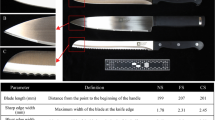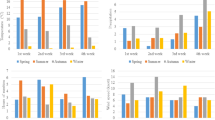Abstract
Purpose
The distinction between cut marks and blunt force injuries on costal cartilages is a crucial issue in the forensic field. Moreover, a correct distinction may further be complicated by decomposition, so the need arises to investigate the distinctive features of lesions on cartilage and their changes over time.
Methods
This study aimed to assess the stereomicroscopic features of cut marks (performed with six different knives) and blunt fractures (performed with a hammer and by means of manual bending) on 48 fragments of human costal cartilages. Moreover, in order to simulate decomposition, the cut and fractured surfaces were checked with stereomicroscopy and through casts after 1 and 2 days, 1 week, and 1, 2 and 4 months of drying in ambient air.
Results
In fresh samples, for single and unique cuts, striations were observed in between 44 and 88 % of cases when non-serrated blades were used, and between 77 and 88 % for serrated blades; in the case of “repeated” (back and forth movement) cuts, striations were detected in between 56 and 89 % of cases for non-serrated blades, and between 66 and 100 % for serrated blades. After only 1 week of decomposition the detection rates fell to percentages of between 28 and 39 % for serrated blades and between 17 and 33 % for non-serrated blades. Blunt force injuries showed non-specific characteristics, which, if properly assessed, may lead to a reliable distinction between different cut marks in fresh samples. The most evident alterations of the structure of the cartilage occurred in the first week of decomposition in ambient air. After one week of drying, the characteristics of cut marks were almost undetectable, thereby making it extremely challenging to distinguish between cut marks, blunt force fractures and taphonomic effects.
Conclusion
The study represents a contribution to the correct assessment and distinction of cut marks and blunt force injuries on cartilages, providing a glimpse on the modifications such lesions may undergo with decomposition.



Similar content being viewed by others
References
Chaudhuri AG, Goswami A, Paul S. Rudiments of biology. Kolkata: Academic Publishers; 2010.
Eroshenko VP. Di Fiore’s atlas of histology with functional correlation. Philadelphia: Lippincott Williams & Wilkins; 2012.
Standring S. Anatomia del Gray. Le basi anatomiche per la pratica clinica, Vol 2. Philadelphia: Elsevier; 2009. p. 87–9.
Anastasi G. Trattato di anatomia umana. Milano: Edi Ermes; 2007.
Bonte W. Tool marks in bones and cartilage. J Forensic Sci. 1975;20:315–25.
Bonte W. Considerations on the identification of notch traces from stabbing injuries. Archiv Kriminologie. 1972;149:77–96.
Andahl R. The examination of saw marks. J Forensic Sci Soc. 1978;18:31–46.
Symes SA. Morphology of saw marks in human bone: identification of class characteristics. PhD dissertation. Department of Anthropology, University of Knoxville, Tennessee; 1992.
Symes SA, Berryman HE, Smith OC. Saw marks in bone: introduction and examination of residual kerf contour. In: Reichs K, editor. Forensic osteology: advances in the identification of human remains. 2nd ed. Springfield: C.C. Thomas; 1998. p. 389–409.
Symes SA, Williams JA, Murray EA, Hoffman JM, Holland TD, Sau JM, et al. Taphonomic context of sharp-force trauma in suspected cases of human mutilation and dismemberment. In: Haglund WD, Sorg MH, editors. Advances in forensic taphonomy. Boca Raton: CRC Press; 2001. p. 403–34.
Watson DJ. The identification of tool marks produced from consecutively manufactured knife blades in soft plastics. AFTE J. 1978;10:43–8.
Rao V, Hart R. Tool mark determination in cartilage of stabbing victim. J Forensic Sci. 1983;28:794–9.
Pounder DJ, Reeder FD. Striation patterns in serrated blade stabs to cartilage. Forensic Sci Int. 2011;208:91–4.
Pounder DJ, Cormack L, Broadbent E, Millar J. Class characteristics of serrated knife stabs to cartilage. Am J Forensic Med Pathol. 2011;32:157–60.
Pounder DJ, Sim LJ. Virtual casting of stab wounds in cartilage using micro-computed tomography. Am J Forensic Med Pathol. 2011;32:97–9.
Love C, Derrick S, Wiersema J, Peters C. Validation of tool mark analysis of cut costal cartilage. J Forensic Sci. 2012;57:306–11.
Pounder DJ, Cormack L. An experimental model of tool mark striations in soft tissues produced by serrated blades. Am J Forensic Med Pathol. 2011;32:90–2.
Pounder DJ, Bhatt S, Cormack L, Hunt BA. Tool mark striations in pig skin produced by stabs from a serrated blade. Am J Forensic Med Pathol. 2011;32:93–5.
Parks CL. A study of the human decomposition sequence in central Texas. J Forensic Sci. 2011;56:19–22.
Brothwell DR. Digging up bones: the excavation, treatment, and study of human skeletal remains. Ithaca, NY: Cornell University Press; 1981.
Kettner M, Potente S, Schulz B, Knauff P, Schmidt PH, Ramsthaler F. Analysis of laryngeal fractures in decomposed bodies using microfocus computed tomography (mfCT). Forensic Sci Med Pathol. 2014;10:607–12.
Jacques R, Kogon S, Shkrum M. An experimental model of tool mark striations by a serrated blade in human soft tissues. Am J Forensic Med Pathol. 2014;35:59–61.
Author information
Authors and Affiliations
Corresponding author
Rights and permissions
About this article
Cite this article
Spagnoli, L., Amadasi, A., Frustaci, M. et al. Characteristics and time-dependence of cut marks and blunt force fractures on costal cartilages: an experimental study. Forensic Sci Med Pathol 12, 26–32 (2016). https://doi.org/10.1007/s12024-015-9734-0
Accepted:
Published:
Issue Date:
DOI: https://doi.org/10.1007/s12024-015-9734-0




